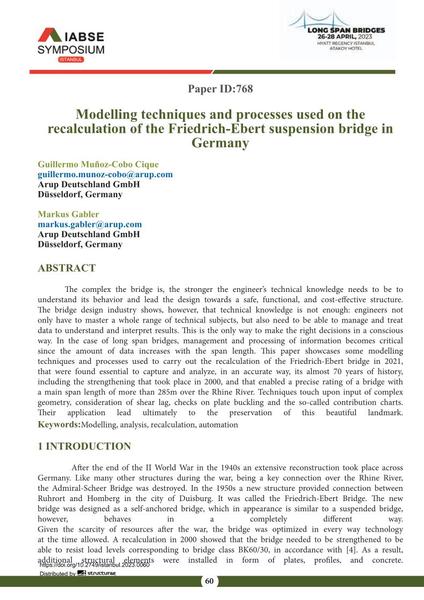Modelling techniques and processes used on the recalculation of the Friedrich-Ebert suspension bridge in Germany

|
|
|||||||||||
Détails bibliographiques
| Auteur(s): |
Guillermo Muñoz-Cobo Cique
(Arup Deutschland GmbH Düsseldorf, Germany)
Markus Gabler (Arup Deutschland GmbH Düsseldorf, Germany) |
||||
|---|---|---|---|---|---|
| Médium: | papier de conférence | ||||
| Langue(s): | anglais | ||||
| Conférence: | IABSE Symposium: Long Span Bridges, Istanbul, Turkey, 26-28 April 2023 | ||||
| Publié dans: | IABSE Symposium Istanbul 2023 | ||||
|
|||||
| Page(s): | 60-68 | ||||
| Nombre total de pages (du PDF): | 9 | ||||
| Année: | 2023 | ||||
| DOI: | 10.2749/istanbul.2023.0060 | ||||
| Abstrait: |
The more complex the bridge is, the stronger the engineer’s technical knowledge needs to be to understand its behavior and lead the design towards a safe, functional, and cost-effective structure. The bridge design industry shows, however, that technical knowledge is not enough: engineers not only have to master a whole range of technical subjects, but also need to be able to manage and treat data to understand and interpret results. This is the only way to make the right decisions in a conscious way. In the case of long span bridges, management and processing of information becomes critical since the amount of data increases with the span length. This paper showcases some modelling techniques and processes used to carry out the recalculation of the Friedrich-Ebert bridge in 2021, that were found essential to capture and analyze, in an accurate way, its almost 70 years of history, including the strengthening that took place in 2000, and that enabled a precise rating of a bridge with a main span length of more than 285m over the Rhine River. Techniques touch upon input of complex geometry, consideration of shear lag, checks on plate buckling and the so-called contribution charts. The ir application lead ultimately to the preservation of this beautiful landmark. |
||||
